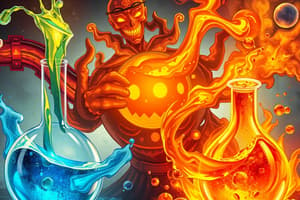Podcast
Questions and Answers
What is the colour change observed in ferrous sulphate crystals when heated?
What is the colour change observed in ferrous sulphate crystals when heated?
- Blue to white
- Yellow to green
- Green to brown (correct)
- Red to black
What gases are emitted when ferrous sulphate is heated?
What gases are emitted when ferrous sulphate is heated?
- Carbon dioxide and water vapor
- Sulphur dioxide and sulphur trioxide (correct)
- Hydrogen and methane
- Oxygen and nitrogen dioxide
Which decomposition reaction is used in the manufacture of cement?
Which decomposition reaction is used in the manufacture of cement?
- Decomposition of calcium carbonate (correct)
- Decomposition of ferrous sulphate
- Decomposition of lead nitrate
- Decomposition of silver nitrate
What are the products formed when lead nitrate is heated?
What are the products formed when lead nitrate is heated?
What type of reaction occurs when a single reactant breaks down to give simpler products upon heating?
What type of reaction occurs when a single reactant breaks down to give simpler products upon heating?
Flashcards are hidden until you start studying
Study Notes
Decomposition Reaction
- A decomposition reaction is a reaction in which a single reactant breaks down to give simpler products.
- Ferrous sulphate crystals (FeSO4, 7H2O) undergo decomposition when heated, resulting in a change of color from green to brown, and emitting a characteristic odour of burning sulphur.
- The decomposition reaction of ferrous sulphate is: 2FeSO4(s) + Heat → Fe2O3(s) + SO2(g) + SO3(g)
- Ferrous sulphate loses water when heated, resulting in the formation of ferric oxide (Fe2O3), sulphur dioxide (SO2), and sulphur trioxide (SO3).
- Ferric oxide is a solid, while SO2 and SO3 are gases.
Thermal Decomposition
- Thermal decomposition is a decomposition reaction that occurs when a substance is heated.
- Example of thermal decomposition: calcium carbonate (CaCO3) decomposes into calcium oxide (CaO) and carbon dioxide (CO2) when heated: CaCO3(s) + Heat → CaO(s) + CO2(g)
- Calcium oxide is also known as lime or quick lime and has many uses, including in the manufacture of cement.
Other Examples of Decomposition Reactions
- Lead nitrate (Pb(NO3)2) decomposes into lead oxide (PbO), nitrogen dioxide (NO2), and oxygen (O2) when heated: 2Pb(NO3)2(s) + Heat → 2PbO(s) + 2NO2(g) + O2(g)
- Silver nitrate (AgNO3) decomposes into silver (Ag), nitrogen dioxide (NO2), and oxygen (O2) when heated: 2AgNO3(s) + Heat → 2Ag(s) + 2NO2(g) + O2(g)
Electrolysis
- Electrolysis is a process in which an electric current is used to drive a chemical reaction.
- Example of electrolysis: when a battery is connected to a solution of dilute sulphuric acid, gas bubbles form at both electrodes, and oxygen is evolved at the positive electrode, while hydrogen is evolved at the negative electrode.
Studying That Suits You
Use AI to generate personalized quizzes and flashcards to suit your learning preferences.




